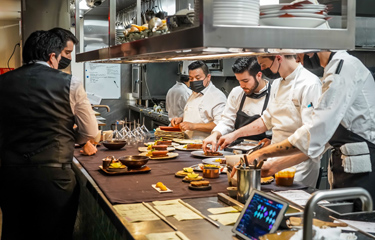A new report from the National Restaurant Association is predicting the U.S. foodservice industry will grow 6 percent to reach USD 898 billion (EUR 786 billion) in sales in 2022.
But the NRA’s 2022 State of the Restaurant Industry Report found it faces numerous existential threats, including rising business costs, an extremely shallow labor pool, and supply chain disruptions. More than half of operators believe it will take more than a year for business conditions to return to normal, the study found.
Seven in 10 U.S. foodservice operators across all major segments said their restaurant currently does not have enough employees to support customer demand and most operators expect their labor challenges to continue through next year. Forty percent of operators say they are not open to full capacity for indoor on-premises dining, and seven in 10 report it’s due to staffing shortages. While the restaurant and foodservice industry added back 1.7 million jobs during 2021, “many restaurants remain severely understaffed, and this will continue to constrain industry growth in 2022,” the NRA report said.
Moreover, the rapid spread of the omicron variant hurt consumer spending and job growth in December, and resulted in depressed restaurant bookings and less travel in January, according to the NRA.
“The omicron variant is another speed bump on the industry’s road to recovery. Most operators across all the major restaurant segments say they’ve seen a decline in customer demand for indoor on-premises dining in late 2021 and early 2022,” the NRA said.
But the economic impact of omicron is more short-lived than earlier COVID-19 waves, Visa Chief Financial Officer Vasant Prabhu told The Wall Street Journal.
“All the indications are that it will be a big year for travel. We see the shift to services continuing to gather momentum,” Prabhu said.
And a strong labor market and rising wages mean will fuel Americans’ traveling and spending more at restaurants, the NRA said. The foodservice industry workforce is projected to grow by 400,000 jobs, reaching 14.9 million employees by the end of 2022. Fifty-one percent of adults said they aren’t eating at restaurants as often as they would like, up six percentage points since before the pandemic, the NRA said.
Ninety-six percent of operators experienced supply delays or shortages of key food or beverage items in 2021 – and those challenges will likely continue in 2022, according to the NRA. Ninety percent of restaurant operators say food costs are higher than they were prior to COVID-19, and six in 10 full-service operators said their menu contains fewer offerings now than it did before the pandemic.
Restaurant menu offerings remain scaled back compared with pre-pandemic levels due to supply delays or shortages of food and beverages, along with inflation, according to Hudson Riehle, senior vice president of the National Restaurant Association Research and Knowledge Group, speaking at the National Fisheries Institute’s Global Seafood Market Conference (GSMC) in Orlando, Florida, U.S.A., on 19 January. Protein costs have risen from 20 to 30 percent or more over the past year and input costs are not expected to change until well into the second half of 2022. Due to soaring food costs, menu prices rose 4.5 percent last year – the highest rate since 2008,
According to the NRA, among consumers who eat seafood, 47 percent of restaurant-goers listed pricing as their top impediment to ordering seafood, followed by harvest method (23 percent), origin (19 percent), and sustainability certifications (12 percent).
“Their most-important consideration in the end does remain price,” Riehle said.
Photo courtesy of Leonard Zhukovsky/Shutterstock







